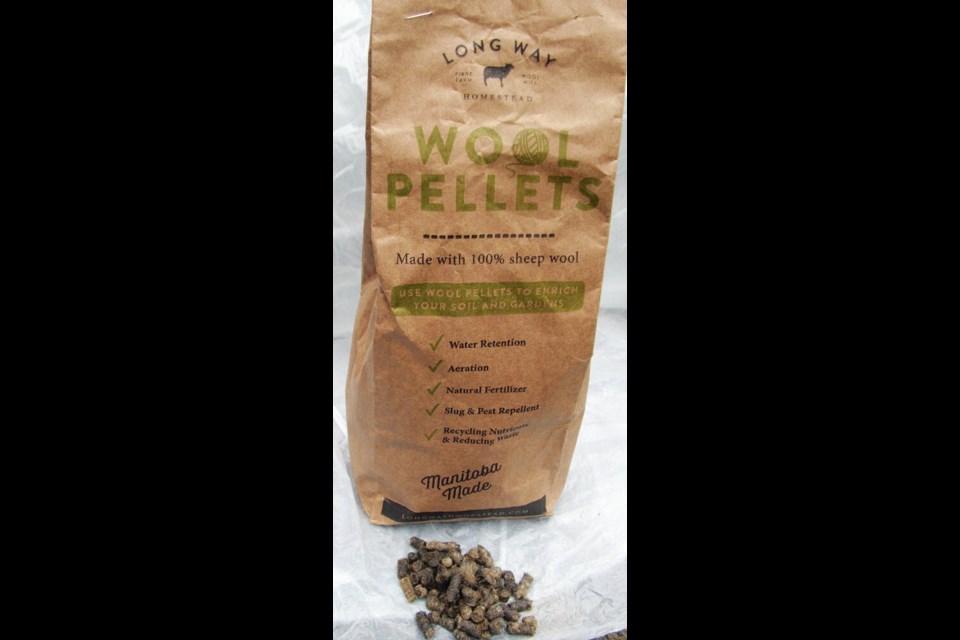One of my friends knows a woman in Wales who has a hobby of working with wool and colouring it with natural, botanical dyes. She uses her tag ends of wool in her large, walled garden, digging the wool lightly into the soil. She also uses pellets made from sheep wool in the garden.
My friend found a Canadian source for the wool pellets, which are both fertilizer and pest repellent. The source my friend, a keen knitter, found is Long Way Homestead in Manitoba. Their pellets are sold in a Vancouver wool store called Baaad Anna’s Yarn Store.
My son is familiar with Baaad Anna’s because he has had his mobile kitchen at several outdoor gatherings of knitters in Vancouver. He always found the knitters a jolly bunch and came to know the owner of Baaad Anna’s.
Guess what I got for Christmas? A bag of Long Way Homestead wool pellets. They look a little like bunny poop. My friend likes the smell. I find it a bit whiffy. I’ve secured the bag in a well sealed container in the carport, lest one of the carnivorous creatures that roam the garden at night becomes attracted to the scent of mutton on the hoof and decides to stick around.
The pellets are made from 100 per cent sheep wool. They absorb and hold water, reducing the amount of watering needed. As they expand, the pellets enhance aeration and increase oxygen levels in the soil.
Wool pellets break down slowly as they release their nutrients into the soil. Wool is high in nitrogen and carbon as well as trace minerals.
Something I did not know before is that wool is a natural slug repellent. Slugs risk drying out from the need to produce too much slime to overcome the tiny irritating barbs in wool. The barrier works only for a while.
Another bonus coming with this gardening aid is that it diverts wool waste from landfills and returns its nutrients to soils.
The pellets can be used in both open and container gardens. In garden plots, scratch them lightly into the soil before seeding or transplanting. Push the pellets into the soil of potted plants. A general guide is to mix one-half cup of the pellets into every four litres of soil.
Plants like tomatoes, peppers and broccoli can benefit from the pellets scratched lightly into the soil surface around them as they begin to form the first fruits and florets.
Wool pellets are becoming increasingly available. T&T Seeds lists pellets made in Alberta. Some B.C wool producers are promising to make a similar product available soon. They can be ordered from Baaad Anna’s, under Accessories. I’ll be watching for local outlets stocking the pellets. They are a superb environmentally helpful product, making use of wool waste to enhance the health and productivity of our gardens.
I’ll be experimenting with the pellets in my garden this spring and summer. And I won’t feel the least bit sheepish about it.
GARDEN EVENTS
Gordon Head meeting. The Gordon Head Garden Club will meet on Wednesday, Feb. 1, from 7 to 9 p.m. in the Gordon Head Lawn Bowling Club, 4105 Lambrick Way. Paul Sprigs will speak about cracks and crevice gardening. Visitors are welcome at no charge to the meeting, which will include a parlour show and raffle.
Seedy in Qualicum. Seeding the Future is the theme of the 19th annual Qualicum Beach Seedy Saturday on Feb. 4, from 10 a.m. to 3.30 p.m. in the QB Civic Centre, 747 Jones St. The large hall will be filled with seed and plant vendors, with more vendors and exhibits outdoors. There will be a seed swap, advice from Master Gardeners, and the Seedy Cafe. A municipal truck will be on hand to receive unwanted pesticides and herbicides. Admission is by donation. qbseedysaturday.ca
Composting basics. The Compost Education Centre, 1216 N Park St. in Victoria, is presenting a workshop on Composting Basics on Saturday, Feb. 4, 10 a.m. to 12 p.m. Learn to make your own backyard compost, a living soil amendment rich in nutrients and micro-organisms. The workshop is free, but please pre-register by calling 250-386-9676, emailing [email protected], or going online at compost.bc.ca/publicworkshops — a site that lists and describes a lengthy series of upcoming workshops. Under “Resources” are lists of fact sheets of interest to gardeners.



